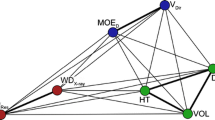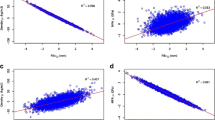Abstract
• Background
Tree breeders have been reluctant to include wood traits in tree improvement programs owing to logistic difficulties and the cost associated with the assessing the traits.
• Methods
We aimed to evaluate the efficiency of two non-destructive techniques for genetic parameters estimation in three diallel test series of loblolly pine (Pinus taeda L.). The traits were measured by acoustics (velocity, stiffness) and predicted by calibration models based on near infrared (NIR) spectra (air-dry density, microfibril angle, modulus of elasticity, coarseness, wall thickness).
• Results
Acoustic and NIR-predicted traits were not correlated with diameter based on 30 full-sib family means of each diallel series. Correlations between traits were in accordance with previous published results. Additive genetic variation was considerable for all traits. Specific combining ability variances were not significant. The traits predicted by acoustic and NIR methods had high narrow-sense individual tree and family mean heritability values. Individual tree narrow sense heritability ranged from 0.14 (tracheid coarseness) to 0.92 (air-dry density). As expected, family mean heritability values of most traits exceeded 0.80.
• Conclusions
The high heritabilities suggest that acoustic and NIR-based methods can efficiently be used for screening loblolly pine progeny tests for surrogate wood traits. Such methods can save considerable resources in tree breeding programs that aim to improve wood quality.
Similar content being viewed by others
References
Atwood RA, White TL, Huber DA (2002) Genetic parameters and gains for growth and wood properties in Florida source loblolly pine in the southeastern United States. Can J For Res 32(6):1025–1038
Auty D, Achim A (2008) The relationship between standing tree acoustic assessment and timber quality in Scots pine and the practical implications for assessing timber quality from naturally regenerated stands. Forestry 81(4):475–487
ASTM International (2009) Annual book of ASTM standards, vol 4.10. ASTM International, Philadelphia, 808 pages
Byram TD, Mullin TJ, White TL, van Buijtenen JP (2005) The future of tree improvement in the southeastern United States: alternative visions for the next decade. South J Appl For 29(2):88–95
Chauhan S, Donnelly R, Huang CL et al (2006) Wood quality: multifaceted opportunities. In: Walker JC (ed.), Primary wood processing. Principles and practice, 2nd edition. Springer, Dordrecht, The Netherlands, pp 159–202
Cogdill RP, Dardenne P (2004) Least-squares support vector machines for chemometrics: an introduction and evaluation. J Near Infrared Spectrosc 12(2):93–100
da Silva Perez D, Guillemain A, Alazard P, Plomion C, Rozenberg P, Rodrigues JC, Alves A, Chantre G (2007) Improvement of Pinus pinaster Ait elite trees selection by combining near infrared spectroscopy and genetic tools. Holzforschung 61(6):611–622
Eckard TJ, Isik F, Bullock B, Li B, Gumpertz M (2010) Selection efficiency for solid wood traits in Pinus taeda using time-of-flight acoustic and micro-drill resistance methods. For Sci 56(3):233–241
Evans R (1994) Rapid measurement of the transverse dimensions of tracheids in radial wood sections from Pinus radiata. Holzforschung 48(2):168–172
Evans R (1999) A variance approach to the X-ray diffractometric estimation of microfibril angle in wood. Appita J 52(4):283–294
Evans R, Ilic J (2001) Rapid prediction of wood stiffness from microfibril angle and density. For Prod J 51:53–57
Evans R (2006) Wood stiffness by X-ray diffractometry. In: Stokke D, Groom L (eds) Characterization of the cellulosic cell wall. Blackwell, Ames, pp 138–146
Falconer DS, Mackay TFC (1996) Introduction to quantitative genetics, 4th edn. Longman Group Ltd., Harlow
Gapare WJ, Ivković M, Baltunis BS, Matheson CA, Wu HX (2010) Genetic stability of wood density and diameter in Pinus radiata D. Don plantation estate across Australia. Tree Gen Genom 6:113–125
Gilmour AR, Gogel BJ, Cullis BR, Welham SJ, Thomson R (2002) ASREML User Guide, Release 1.0. VSN International Ltd, Hemel Hempstead, 267 pages
Isik F, Li B (2003) Rapid assessment of wood density of live trees using the resistograph for selection in tree improvement programs. Can J For Res 33:2426–2435
Isik F, Boos DD, Li B (2005) The distribution of genetic parameter estimates and confidence intervals from small disconnected diallels. Theor Appl Genet 110:1436–2243
Isik F, Gumpertz M, Li B, Goldfarb B, Sun X (2008) Analysis of cellulose microfibril angle (MFA) using a linear mixed model in Pinus taeda clones. Can J For Res 38:1676–1689
Jacques D, Marchal M, Curnel Y (2004) Relative efficiency of alternative methods to evaluate wood stiffness in the frame of hybrid larch (Larix x eurolepis Henry) clonal selection. Ann Forest Sci 61:35–43
Kelley SS, Rials TG, Snell R, Groom LH, Sluiter A (2004) Use of near infrared spectroscopy to measure the chemical and mechanical properties of solid wood. Wood Sci Technol 38:257–276
Kumar S, Jayawickrama JS, Lee J, Lausberg M (2002) Direct and indirect measures of stiffness and strength show high heritability in a wind-pollinated radiata pine progeny test in New Zealand. Silvae Genet 51(5–6):256–261
Li B, McKeand S, Weir R (1999a) Tree improvement and sustainable forestry — impact of two cycles of loblolly pine breeding in the U.S.A. For Genet 6(4):229–234
Li B, McKeand SE, Weir RJ (1999b) Impact of forest genetics on sustainable forestry — results from two cycles of loblolly pine breeding in the U.S. J Sustain For 10(1-2):79–85
Lindström H, Harris P, Sorensson CT, Evans R (2004) Stiffness and wood variation of 3-year old Pinus radiata clones. Wood Sci Technol 38:579–597
Lynch M, Walsh B (1998) Genetics and analysis of quantitative traits. Sinauer Associates, Inc., Sunderland, MA, USA
Megraw RA (1985) Wood quality factors in loblolly pine. The influence of tree age, position in tree, and cultural practice on wood specific gravity, fiber length and fibril angle. Tappi Press, Norcross, GA, USA
Mora CR, Schimleck LR, Isik F, Mahon J Jr, Clark A III, Daniels R (2009) Relationships between acoustic variables and different measures of stiffness in standing Pinus taeda trees. Can J For Res 39(8):1421–1429
Mora CR, Schimleck LR (2009) Kernel regression methods for the prediction of wood properties of Pinus taeda using near infrared (NIR) spectroscopy. Wood Sci Technol, doi:10.1007/s00226-009-0299-5
Poke FS, Raymond CA (2006) Predicting extractives, lignin, and cellulose contents using near infrared spectroscopy on solid wood in Eucalyptus. J Wood Chem Technol 26(2):187–199
Raymond CA, Schimleck LR, Muneri A, Michell AJ (2001) Genetic parameters and genotype-by-environment interactions for pulp yield and pulp productivity in Eucalyptus globulus predicted using near infrared reflectance analysis. For Genet 8(3):213–224
Raymond CA, Schimleck LR (2002) Development of near infrared reflectance analysis calibrations for estimating genetic parameters for cellulose content in Eucalyptus globulus. Can J For Res 32(1):170–176
Schimleck L (2008) Near infrared spectroscopy: A rapid, non-destructive method for measuring wood properties and its application to tree breeding. New Zeal J Forest Sci 38:14–35
Schimleck LR, Kube PD, Raymond CA (2004) Genetic improvement of kraft pulp yield in Eucalyptus nitens using cellulose content determined by near infrared spectroscopy. Can J For Res 34(11):2363–2370
Schimleck LR, Evans R, Illic J (2001) Estimation of Eucalyptus delegatensis wood properties by near infrared spectroscopy. Can J For Res 31(10):1671–1675
Shelbourne T, Evans R, Kibblewhite P, Low C (1997) Inheritance of tracheids transverse dimensions and wood density in radiata pine. Appita J 50(1):47–50, 67
Suykens JAK, Van Gestel T, De Brabanter J, De Moor B, Vandewalle J (2002) Least squares support vector machines. World Scientific Publishing, Singapore
Sykes R, Li B, Isik F, Kadla J, Chang H-m (2006) Genetic variation and genotype by environment interactions of juvenile wood chemical properties in Pinus taeda L. Ann Forest Sci 63(8):897–904
Wang X, Ross RJ, Erickson JR, Ligon JB (2000) Nondestructive evaluation of trees. Exp Tech 24(6):27–29
Wear DN, Greis JG (2002) Southern forest resource assessment, General Technical Report SRS 53. Asheville, NC. Southern Research Station
Wu H, Powell MB, Yang JL, Ivkovic M, McRae TA (2007) Efficiency of early selection for rotation-aged wood quality traits in radiata pine. Ann Forest Sci 64(1):1–9
Zobel BJ, van Buijtenen JP (1989) Wood variation its causes and control. Springer series in wood science. Springer, New York, 363 pages
Acknowledgement
This research was supported by an USDA Forest Service Agenda 2020 grant. The authors gratefully acknowledge support from the Wood Quality Consortium of the University of Georgia, the USDA Forest Service Southern Research Station, and the North Carolina State University Cooperative Tree Improvement Program. The second author thanks Bioforest S.A. for the support to complete this work. Special thanks to Tyler Eckard for his help in data collection.
Author information
Authors and Affiliations
Corresponding author
Additional information
Handling Editor: Luc Pâques
Appendix
Appendix
Rights and permissions
About this article
Cite this article
Isik, F., Mora, C.R. & Schimleck, L.R. Genetic variation in Pinus taeda wood properties predicted using non-destructive techniques. Annals of Forest Science 68, 283–293 (2011). https://doi.org/10.1007/s13595-011-0035-9
Received:
Accepted:
Published:
Issue Date:
DOI: https://doi.org/10.1007/s13595-011-0035-9




